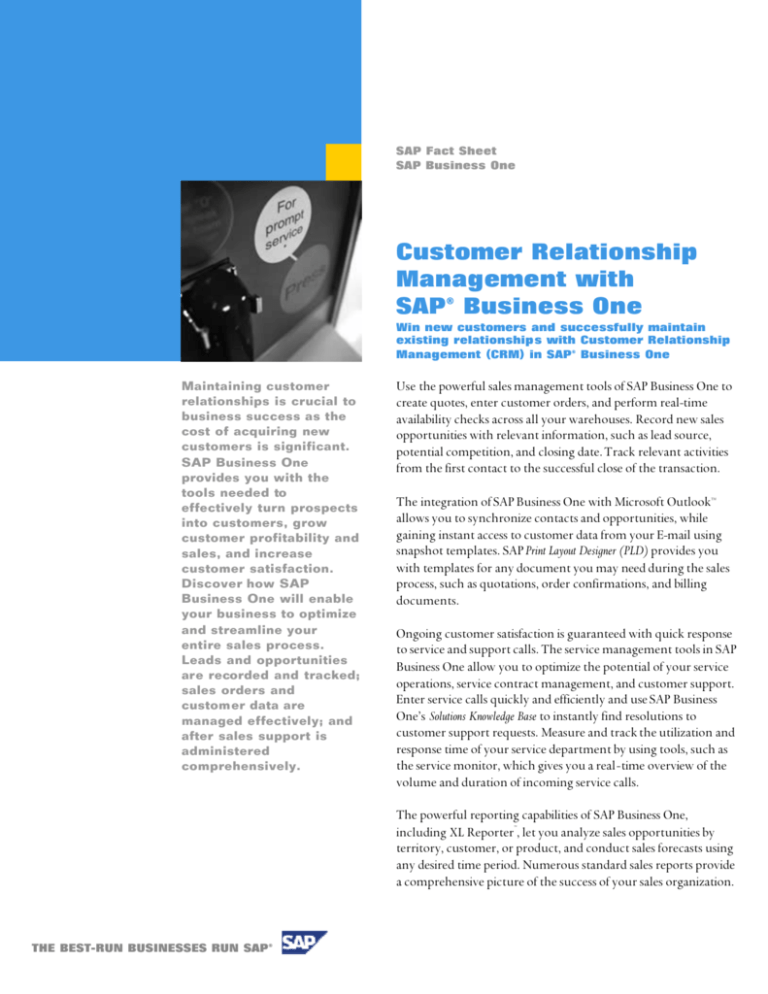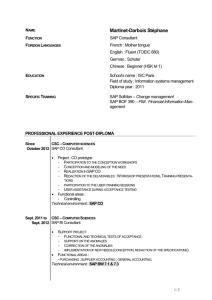
SAP Fact Sheet
SAP Business One
Customer Relationship
Management with
SAP® Business One
Win new customers and successfully maintain
existing relationship s with Customer Relationship
Management (CRM) in SAP® Business One
Maintaining customer
relationships is crucial to
business success as the
cost of acquiring new
customers is significant.
SAP Business One
provides you with the
tools needed to
effectively turn prospects
into customers, grow
customer profitability and
sales, and increase
customer satisfaction.
Discover how SAP
Business One will enable
your business to optimize
and streamline your
entire sales process.
Leads and opportunities
are recorded and tracked;
sales orders and
custom er data are
managed effectively; and
after sales support is
administered
comprehensively.
Use the powerful sales management tools of SAP Business One to
create quotes, enter customer orders, and perform real-time
availability checks across all your warehouses. Record new sales
opportunities with relevant information, such as lead source,
potential competition, and closing date. Track relevant activities
from the first contact to the successful close of the transaction.
The integration of SAP Business One with Microsoft Outlook™
allows you to synchronize contacts and opportunities, while
gaining instant access to customer data from your E-mail using
snapshot templates. SAP Print Layout Designer (PLD) provides you
with templates for any document you may need during the sales
process, such as quotations, order confirmations, and billing
documents.
Ongoing customer satisfaction is guaranteed with quick response
to service and support calls. The service management tools in SAP
Business One allow you to optimize the potential of your service
operations, service contract management, and customer support.
Enter service calls quickly and efficiently and use SAP Business
One’s Solutions Knowledge Base to instantly find resolutions to
customer support requests. Measure and track the utilization and
response time of your service department by using tools, such as
the service monitor, which gives you a real-time overview of the
volume and duration of incoming service calls.
The powerful reporting capabilities of SAP Business One,
including XL Reporter™, let you analyze sales opportunities by
territory, customer, or product, and conduct sales forecasts using
any desired time period. Numerous standard sales reports provide
a comprehensive picture of the success of your sales organization.
THE BEST-RUN BUSINESSES RUN SAP®
Customer Relationship Management in SAP Business One
Opportunities and Sales
Business Partners
Service
Convert prospects into customers by
tracking activities and using workflow
management
Manage lead and customer data in simple
user interface
Administer warranty and service
information with contracts and customer
equipment cards
Create instant price quotes and perform
product availability checks online
Access customer balances, credit lines,
and open orders from master data screen
Respond to customer service requests
from central location
Generate sales documents with Print
Layout Designer™ (PLD)
View contacts with Microsoft Outlook™
Search for solutions to customer
problems in online knowledge database
Create dashboards with XL Reporter™ for
forecasting and sales analysis
Use ‘Drag & Relate’ to generate business
partner reports
Monitor service levels with alerts and
reports
Figure 1: Features of SAP Business One Customer Relationship Management
Opportunities and Sales Management
No matter which channel you use or how complex the
prospecting process, you can record and track sales opportunities
in SAP Business One.
SAP Business One enables you to efficiently manage your tasks and
information throughout the sales cycle. Schedule phone calls and
meetings, assign tasks, create detailed notes, and other activities
and be reminded when they are due. Activities entered into your
calendar in SAP Business One can be synchronized with your
schedule in Microsoft Outlook™.
All activities can be linked to business partners and documents.
For example, link activities to a sales lead, and later drill down into
these activities from the lead screen. Reporting capabilities in SAP
Business One provide you with an overview of both your ongoing
and future activities, as well as those of your sales employees.
The sales opportunities module in SAP Business One lets you
manage the entire sales process as it progresses through different,
custom defined sales stages. It tracks sales opportunities and sales
activities, analyzes their outcome, and forecasts revenue potential.
For a complete sales framework, SAP Business One allows you to
define sales stages, partners, competitors, and relationships that
apply to sales opportunities. Enter new opportunities in SAP
Business One with information about potential sales volume, the
customer, specific competitors or partners, expected closing
dates, and sales stages. SAP Business One enables you to classify
sales opportunities according to custom defined criteria for
accurate processing. A gross profit and expected revenue is
immediately calculated by SAP Business One. As the opportunity
progresses through the various sales stages and new data is
entered, the expected profit and revenue calculations are
continuously updated to accurately reflect the current situation.
Once a sales opportunity is won, you can directly create a sales
order without having to reenter data. SAP Business One
integration features allow you to perform instant online
availability checks for ordered products. In addition, accounting
data and inventory levels are immediately updated without the
need for user interaction. Using the SAP Print Layout Designer, you
can define templates for all your sales documents. Templates can
automatically be applied when you generate outbound
documents, such as quotations, order confirmations, and change
confirmations.
Monitor
ongoing sales
opportunities
and quickly
react to
changes
Figure 2: Sales pipeline monitor
Numerous reports in SAP Business One allow you to monitor sales
activities as well as analyze sales opportunities based on customer,
sales stage, expected volume, closing probability, and closing date.
Business Partner Management
SAP Business One makes it easy to manage master data for sales
leads and customers. A dedicated business partner master module
is used to create and maintain lead and customer data in userfriendly screens.
SAP Business One stores general business partner data, such as
name, address, phone and fax numbers, email addresses, contact
persons, and tax information. In addition, you can manage
important payment data, such as terms, credit limits, and special
discounts, as well as bank and credit card information.
Data stored in a business partner master record is automatically
transferred into the relevant transactions, such as sales quotations,
orders, or deliveries. You are notified, if credit limits have been
exceeded or if a customer is ‘on hold’ due to delivery or payment
issues.
A dash board in the customer master record gives you an
overview of the account balance, outstanding orders and
deliveries, as well as opportunities in the pipeline. Data can be
viewed in graphical format, for example, in a sales analysis report
with revenue and profit for a customer.
Service
The service management module in SAP Business One allows you
to efficiently administer customer warranty and service contracts
and manage service calls. Service contracts can be based on
warranted products you are selling, but can also be created
separately for support services rendered for a third party product.
SAP Business One integration functionality automatically
generates a service contract for relevant products upon creation
of a delivery or A/R invoice. The service contract is based on a
predefined template and contains information about items
covered under the agreement, service and response times, as well
as other warranty information.
Serial number management and auto-creation of customer
equipment cards (CEC) can be activated. A customer equipment
card is issued upon delivery or invoice posting of a serial number
item, and contains information about the item, the customer,
and service contracts. It also provides direct access to sales data,
service calls, and other recorded transactions.
www.sap.com/contactsap
SAP Business One enables you to document all customer service
calls. A service call record includes information about the
customer, the service item, the issue reported, and activities
performed in response to the call. SAP Business One maintains a
Solutions Knowledge Base where known issues are stored. The
solutions knowledge base provides service representatives with
possible solutions to a reported problem, allowing them to
immediately respond to a customer call.
The reporting capabilities of SAP Business One give you a real
time overview of your service department, letting you analyze
call volumes, call durations, and response times. The service call
monitor records limits for call durations and call volumes and
creates alerts when those limits are exceeded.
Micros oft Excel™
integration
makes it easy
to create
sophisticated
sales reports
with XL Reporter
Figure 3: XL Reporter sales report samples
Sales Reports and Analysis with XL Reporter™
Microsoft Outlook™ Integration
The Microsoft Outlook™ add-on for SAP Business One allows you
to synchronize calendars and tasks and import customer data
from SAP Business One into your Outlook contacts list.
The quotation function included in the Microsoft Outlook™ addon enables you to display and edit existing quotations directly in
Microsoft Outlook. You can create new quotations in Microsoft
Outlook, store them in SAP Business One, and send them as an email to your prospect or customer. E-mails sent and received in
Microsoft Outlook™ can be saved and retrieved as activities in SAP
Business One. Using the SAP ‘Snapshot feature, you can define a set
of data about a customer or lead and export it into Microsoft
Excel™. The exported data can then be associated with a record in
your Microsoft Outlook™ contact list.
© 2006 by SAP AG. All rights reserved. SAP, R/3, mySAP, mySAP.com, xApps, xApp, SAP NetWeaver, and other SAP products and
services mentioned herein as well as their respective logos are trademarks or registered trademarks of SAP AG in Germany and in
several other countries all over the world. All other product and service names mentioned are the trademarks of their respective
companies. Data contained in this document serves informational purposes only. National product specifications may vary. Printed on
environmentally friendly paper. These materials are subject to change without notice. These materials are provided by SAP AG and its
affiliated companies (“SAP Group”) for informational purposes only, without representation or warranty of any kind, and SAP Group
shall not be liable for errors or omissions with respect to the materials. The only warranties for SAP Group products and services are
those that are set forth in the express warranty statements accompanying such products and services, if any. Nothing herein should be
construed as constituting an additional warranty.
XL Reporter in SAP Business One enables you to create powerful
sales reports using Microsoft Excel templates. With the Report
Designer and the Report Composer, you can create dashboards, such as
top customer and deal overview, YTD revenue, open orders, and
open receivables. The same tools let you create detailed sales
reports, such as opportunities forecasting, pipeline tracking,
win/loss analysis, and sales order analysis. SAP provides a large
number of templates to give you a head start on your sales
reporting. The Report Organizer in SAP Business One helps you
manage and execute your reports and allows for easy distribution
to sales employees and business partners.
To learn more about how SAP Business One can empower your
sales and service organization to grow your business and
effectively service your customers, call your SAP representative
today or visit us on the Web at www.sap.com/smb.
THE BEST-RUN BUSINESSES RUN SAP®









